 Pirates and Privateers Pirates and Privateers
The History of Maritime
Piracy
Cindy Vallar, Editor
& Reviewer
P.O. Box 425,
Keller, TX 76244-0425
    
Books for Adults ~ Historical
Fiction: Pirates & Privateers and Nautical Fiction
Flint
and Silver
Pieces of
Eight
Skull and
Bones
The Traitor
of Treasure Island
Fletcher and
the Blue Star
Fletcher and
the Flying Machine
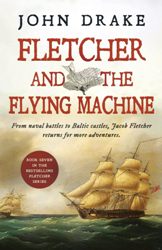
Fletcher and the Flying Machine
By John Drake
Lume Books, 2022, ISBN 978-1-83901-458-1, US $12.99
Also available in e-book formats
    
Nothing normal happens to
Fletcher (also known as Sir Jacob Fletcher
or Jacky Flash). Unless you’ve encountered
one of his previous escapades, the names
probably mean little, so who is he? He’s
the illegitimate son of a knight of the
realm, who never wanted to be in the Sea
Service, but was pressed into the navy
upon the devious scheming of the one woman
who abhors him – Lady Sarah Coignwood, his
stepmother. He also has a particular
interest in the latest technology of the
time – 1803 to 1804 in this case – and the
more radical the concept the better. This
encounter involves aerial navigation and a
flying carriage.
When our story opens, Fletcher is on the
outs with the Admiralty in spite of the
country being at war with France. To pass
the days, he spends time with his sister
in the countryside, where he encounters
ingenious neighbors. A young boy named
Arthur Bayley and his grandfather are
flying a kite, but theirs is no ordinary
flying machine. This one is big enough and
strong enough to carry a man. His
fascination piqued, Fletcher immediately
befriends them and, during the ensuing
days, learns that he’s going to be
recalled into active service. Arthur, who
is struck by a bit of hero worship,
requests that he be allowed to go to sea
with Fletcher – a boon that Fletcher
grants even though he’s wary of ever
regaining the Admiralty’s favor.
Of course, he does, but hasn’t a clue as
to why. The assignment initially seems
enticing until he discovers no one else
wants it. Why? Because the Sea Service is
unable to provide all he needs to carry
out his mission, which is protecting the
whole of Ireland from a French invasion.
The Irish, who are forever at odds with
themselves, have united in hopes of
gaining Bonaparte’s assistance in rising
up against the English and tossing them
out of Ireland. The British have no
intention of allowing this, but there are
many things that can go wrong, which makes
Fletcher just the man for the job. He will
either sink or swim and, should he sink,
he’s the perfect scapegoat.
Setting Fletcher up to take the fall isn’t
that unusual. His knack for out-of-the-box
thinking has saved his life and those of
his men, as well as the honor of the Sea
Service and the country, more than once
before. Being kept in the dark about
certain matters puts Fletcher on his toes
and he adeptly manages with what he’s got
and each and every man under him gives his
all, including Bayley. A ship fire, a
lopsided sea battle pitting Fletcher’s
meager squadron against French warships, a
fractious alliance between Irish rivals,
the captivating Irish woman (deemed a
witch by some) who keeps them united, and
a haughty, by-the-book dragoon lead
Fletcher on a merry, but bloody, escapade
that eventually lands him in jail. But
machinations – both good and bad – are
afoot to once again employ Fletcher in an
impossible scheme to extricate a Russian
grand duchess from a Baltic castle that’s
been under siege for two years. If the
honorable and esteemed Edward Pellew
couldn’t manage it, how in the world will
Fletcher?
This is my first foray into Admiral Sir
Jacob Fletcher’s memoirs, but this seventh
book in the series is a rousing romp.
Drake expertly crafts a serpentine
labyrinth that neatly combines the
improbable with the outlandish in a manner
that is both believable and compelling.
There are moments of levity, but Drake
tells it as it is, neither sugarcoating
the violence nor avoiding compromising
situations of a more intimate nature,
which is why this book is for mature
readers. He includes a gripping depiction
of why seamen fear fire, and historical
details and navy life are seamlessly
interwoven into the story.
Fletcher is an “enormous” character – both
literally and figuratively – who is
larger-than-life and charismatic in ways
that endear him to the common man even
though he stands on the quarterdeck,
otherwise known as officer territory.
The majority of the story unfolds from his
first-person perspective with occasional
interludes to provide readers with a
fuller account of what transpires. The
Rev. Dr. Samuel Pettit, who transcribes
Fletcher’s twenty-five-volume memoirs,
inserts intermittent bracketed comments
that chastise or contradict Fletcher.
Third-person scenes share background
glimpses of the story that Fletcher has no
way of knowing but are key to fully
understanding what transpires.
Fletcher and the Flying Machine is
riveting, complex, preposterous, and
entertaining. Whether you’re a diehard fan
of Jacky Flash or a newcomer like Arthur
Bayley, Drake will soon snare you in an
audacious adventure that eagerly has you
waiting for another madcap adventure.
Review Copyright ©2022
Cindy Vallar

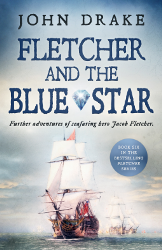
Fletcher and the Blue Star
By John Drake
Lume Books, eBook ISBN 978-1-83901-269-3, UK
£1.99 / US $2.99
Print ISBN 978-1-83901-426-0, UK £9.99 / US
$13.99
reviewed by Irwin Bryan
The
sixth Fletcher book is a welcome addition to
this series. Although he resigned his Royal
Navy commission in the previous book, a way
has been contrived to see him back in command
of a king’s ship again in 1801.
And what a
ship! Tromenderon is a new 90-gun
ship of the line with the speed of a frigate
and 32-pounders on every deck. A special ship
that needs a special captain: Captain Jacob
“Jacky Flash” Fletcher. To the Admiralty, he
is respected as a master at his craft whose
ships always have the best rate of fire and
most accurate gunnery. His men love him with
almost religious fervor as the captain who
takes the most prizes and loses the fewest
men.
The reason the
British government wants Fletcher as Tromenderon’s
captain is because the wonderful ship is
not the only one like it afloat. Fletcher
needs to take his ship to Boston to find and
face three new French ships that are armed and
sail like his. The resulting battle takes
chapters of intense action to tell.
After Fletcher
boards the last captured vessel, he retrieves
the Blue Star from the hands of his enemy.
This large and wondrous diamond may have come
from a mine in Africa.
This author’s
books often have a second story that runs
parallel to the first, with most chapters
starting with this second thread. In this
case, the book begins with a negotiation
between an Arab and an unknown individual
about capturing fifty virgin Zulu women. As
the tale progresses, we are introduced to the
Zulu nation, their religion, and their
rituals. Even though this portion of the book
is interesting – if a bit tedious at times –
it’s very different from what’s happening on Tromenderon.
This second story is not why I read this book,
but the disparate stories finally merge about
two-thirds through the it.
In England,
Fletcher takes the Blue Star to the foreign
secretary and tells him about the mine.
Astronomers want to view a solar eclipse, but
it won’t be visible in England. The secretary
and Fletcher hatch a plan to use the eclipse
as an excuse to send a king’s ship to Africa
and the expedition sets sail aboard Tromenderon.
While the astronomers wait for the eclipse,
Fletcher searches for the mine in hopes of
bringing the rest of the diamonds home to
England.
He cooperates
with the village leader and helps him be
victorious in battle against a rival neighbor.
He also intends to use the eclipse as great
magic to remove the influence of the local
witches. If all goes well, his reward will be
the diamonds. Dealing with the Zulus and their
rituals, however, proves challenging for him
and his men, especially since their lovely
women are naked.
Some
traditionalists may think to pass up this
story since there never was a 90-gun ship of
the line with the speed of a frigate, but they
would be doing themselves a disservice. Tromenderon
only battles the similar French ships so
there is no advantage, and the battle is a
great read.
This is a fun,
rousing book with plenty of action, humor, and
characters that come to life on these pages.
The exotic descriptions of Africa make it seem
as if you are there. If you are looking for an
exciting book or a lighthearted page turner, Fletcher
and the Blue Star is for you.
Review
Copyright ©2021 Irwin Bryan

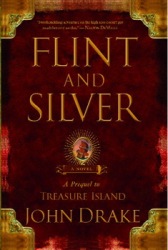
Flint and Silver
By John Drake
Simon & Schuster, 2010, ISBN
9781416592778, US $22.99
2009, e-book
ISBN 9781439130315, US
$10.93
HarperCollins, 2010, ISBN 978-0-00-726894-8,
UK £7.99
2008, e-book
ISBN 978-0-00-730316-8, UK
£4.99
    
reviewed by
Irwin Bryan
If
you read and loved Robert
Louis Stevenson’s Treasure
Island, you were
left with questions about
how and why the treasure
was buried, where Silver’s
parrot came from, and
certainly wondered how
Silver lost his leg.
Luckily, John Drake
pondered these same issues
and decided to write a
series of prequels to Treasure
Island. Finally,
these and other questions
are plausibly answered in
Flint and Silver.
At
first, the chapters jump
from one date to another
and from Flint to Silver.
This can make keeping
track of things and going
with the flow a bit
difficult. Once Flint and
Silver meet, you realize
the opening chapters allow
each person’s character
and history to be
established separately,
and the flow of events
gets easier.
Flint
is clearly evil and vile.
Silver is nicer and more
honorable. Together, these
men captain two pirate
crews joined together. The
various forms of riches
each crew acquires
separately are pooled
together and added to with
more piratical captures.
Then
Flint launches his plan to
bury the treasure on his
secret island. His crew
will agree to whatever he
says. But Silver, and then
his crew, doesn’t agree
and a rift forms. Debate
and conflict are the
result.
Obviously,
if you read Treasure
Island that is,
Flint has his way and the
riches get buried in a
secret spot. He takes
extra steps to ensure the
location is known only to
him. A battle between the
two crews leaves Silver’s
wrecked on the island and
Flint sailing away. Thus
setting the stage for a
confrontation in the
second book, Pieces of
Eight. (I read the
first chapter of the
second book. At the end I
had a very sinister
laugh!)
This
trilogy, which begins with
Flint and Silver,
is for adults only, meshes
very well with Stevenson’s
original work, and answers
the questions the original
work leaves in our minds.
Better yet, these books
are a great read full of
exciting action and
colorful characters.
Review Copyright ©2013 Irwin Bryan

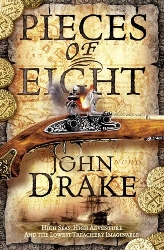 Pieces of Eight
Pieces of Eight
By John Drake
HarperCollins, 2010, ISBN
978-0-00-726896-2, AUS $24.99 / UK £7.99
2009, e-book ISBN
978-0-00-733223-6, UK £5.99
    
reviewed
by Irwin Bryan
In Pieces of Eight,
the second book of the Flint and Silver
trilogy, John Drake continues his
prequel to Treasure Island. I
think the first book is a great read,
and it was, but this next book is a
fantastic read!
There are times when
pivotal events happen in the span of
two or three pages that totally take
me by surprise. All the elements of a
good pirate tale are found in this one
novel: pirates chasing merchant ships,
naval ships chasing pirates,
in-fighting among the brethren, a
beautiful woman to add a little
conflict and romance, cannon fire and
casualties, stormy seas, and always
the buried treasure to be secured.
For Flint and his
crew, the action takes place heading
to Charleston and then back to his
island. Silver and his crew are on the
island, taking steps to prepare and
defend it from the vast number of
fighters he expects Flint to return
with. In this he guesses correctly,
but even he never expects to fight the
enemy his crew ends up facing. Flint
returns with a vengeance and an army
ready and able to do his bidding.
That’s as much
substance as I’ll share. But I’ll tell
you this: the cover of the book
advertises “High Seas, High Adventure,
Lowest Treachery.” All can be found in
this one story, and you can never
imagine how low the treachery will go!
The story culminates
in more surprises and unresolved
issues. I’m glad I have the third
book, Skull and Bones, on hand
to begin reading immediately!
Review Copyright ©2013
Irwin Bryan

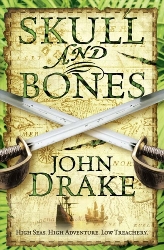 Skull and Bones
Skull and Bones
By John Drake
HarperCollins, 2011, ISBN
978-0-00-726899-3, UK £7.99 / AUS $24.99 /
CAN $17.99
eBook ISBN 978-0-00-736614-9, UK £13.99
    
reviewed
by Irwin Bryan
Usually when you read a
trilogy, the third or last book is
about the final push toward the goal,
the culmination of efforts to achieve
success, or the end of a voyage or
trek to a homecoming. In John
Drake’s third book in the series, Skull
and Bones, you read how Flint
and Silver fail to obtain their
treasure or reconcile their
differences. This neatly sets up
Robert Louis Stevenson’s Treasure
Island at the beginning of his
classic tale. They, or at least
Silver’s crew, is already on the
island holding the treasure. Flint
succeeds in dealing with Silver’s crew
and the threat they pose to his
wealth. The next thing you know,
another interloper drives them all
from the island.
In the
process Silver regains his ship and
convinces the crew to sail for England
and redemption of a kind. Flint,
without a ship or a crew, finds
suitable accommodation on an English
warship and also heads for England and
his own attempt at redemption.
Although
that redemption may not all work out
as they each hope, they leave England
as one crew, with Flint and Silver
each holding half of the map to the
treasure and heading for the island to
reclaim it. Greed, jealousy, and fate
conspire against them, and the
survivors leave empty-handed and
altered by the experience.
John
Drake’s Flint & Silver trilogy is
wonderfully entertaining, and I
heartily recommend the books to anyone
thinking of returning to Treasure
Island! There’s also an author’s
comment at the end that indicates
Drake may be writing his own version
of Treasure Island!
Review Copyright ©2013
Irwin Bryan

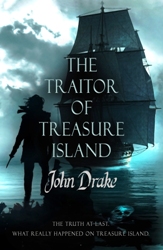 The Traitor
of Treasure Island: The Truth at Last.
What Really Happened on Treasure Island.
The Traitor
of Treasure Island: The Truth at Last.
What Really Happened on Treasure Island.
By John Drake
Endeavour Quill, 2019, ISBN
978-1-911445-72-2 UK £7.99 / US $9.99
    
reviewed
by Irwin Bryan
This new book is the
fourth in Drake’s Flint and Silver
series. I recommend you read the other
books first – not because you need to
for the sake of clarity – they’re just
great books you shouldn’t miss. Anyone
familiar with the story of Treasure
Island knows enough to read and
enjoy this book by itself.
Almost every
character that appears in
Stevenson’s original story can be
found within these pages. There are
the pirates (Billy Bones, Israel
Hands, Blind Pew, Flint, and Long
John Silver), the map-holding
treasure-hunting Squire Trelawney
and Dr. Livesey, and even the boy,
Jim Hawkins.
These represent
three separate groups hoping to
recover the treasure. The squire
fits out a ship, the Hispaniola,
for the expedition and inadvertently
hires Long John Silver as the cook
and his henchmen as part of the
crew. They travel together to the
island. Flint sails his own ship and
pirate crew there. All the players
expect to recover the treasure or
take it from those who do.
Once they arrive at
their destination the real fun
begins. As soon as Hispaniola anchors,
the crew is given a chance to land
and relax after the long journey.
Unknown to the squire, Silver knows
where weapons are stored, and the
pirates arm themselves with muskets,
pistols, and cutlasses. Once back on
the beach they board the boats
intent on taking the ship for
themselves.
To avoid a deadly
confrontation, the doctor convinces
the squire and loyal men to take a
boat to the island and give up the
ship for now. On shore they head to
the only building, the same
blockhouse where Silver armed his
men. These
two groups engage in combat, and
members from both fall in a war of
attrition. Situations change once
Flint arrives at the island to carry
out his own evil designs.
But I don’t plan on
revealing any more of the story
here. To find out who lives and who
dies, if the treasure is found, or
if anyone succeeds in bringing it
home, you’re going to have to read
the book for yourselves.
I will say this
regarding the book’s title: Jim
Hawkins is the traitor. Gone is the
innocent lad of Stevenson’s tale. At
first, I was not happy with Hawkins
cast as the traitor. But he really
excels in “traitoring,” and it’s a
more natural fit than I ever
expected!
Once the island
adventure ends, Drake provides an
epilogue that ties up the loose ends
and sheds light on the surviving
characters and their futures. An
afterword includes Long John
Silver’s articles that all the
pirates sign; a note about alcohol
consumption in the 18th century; a
comment about the value of the
buried treasure; and the full text
of the Royal Navy Prayer mentioned
in the story.
If you’re looking
for a fun book with a great story,
there’s no need to look any further.
This one has action, excitement, and
even some laughs. You’ll find
piratical acts, shifting alliances,
and numerous plot twists. In time,
this will be considered one of the
classic tales of the pirate genre.

Click to contact me
Background image compliments
of Anke's Graphics |






